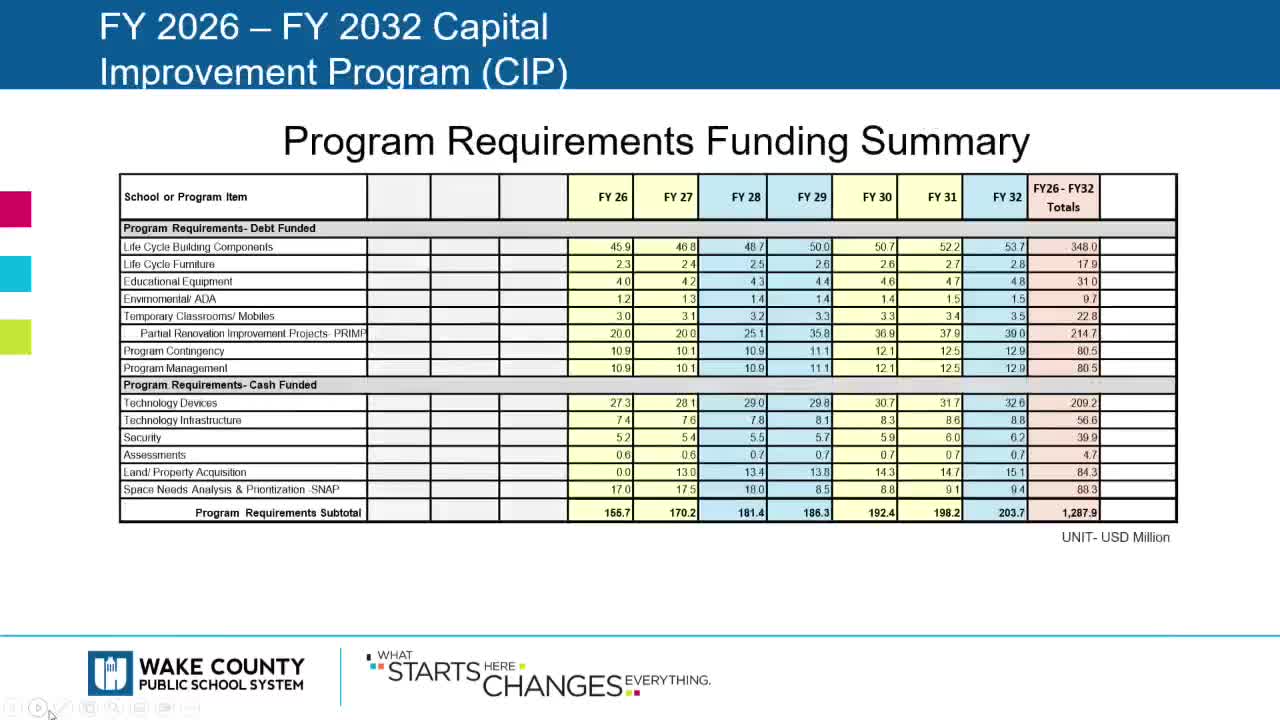Wake County Schools unveil $3 billion seven-year capital improvement plan
May 12, 2025 | Wake County, North Carolina
This article was created by AI summarizing key points discussed. AI makes mistakes, so for full details and context, please refer to the video of the full meeting. Please report any errors so we can fix them. Report an error »

During the Wake County government meeting on May 12, 2025, officials discussed significant developments in the funding and planning of educational infrastructure, highlighting a substantial increase in budget allocations for life cycle projects within the Wake County Public Schools system.
The meeting revealed that the budget for life cycle projects—those that have surpassed their useful life by five years—has nearly doubled from approximately $20 million to nearly $46 million for fiscal year 2026. This increase reflects a concerted effort by the Capital Improvement Program (CIP) and core teams to address the pressing needs of the district. The collaborative approach has allowed for a more flexible allocation of resources, ensuring that the most critical projects receive necessary funding.
A noteworthy point raised during the discussions was the zero allocation for land and property acquisition in the upcoming fiscal year. Officials clarified that this does not indicate a lack of need for new school sites; rather, it signifies a strategic decision to reallocate funds to more immediate projects. The planning department remains vigilant in identifying suitable land for future school developments, utilizing data projections and collaboration with local municipalities.
The total budget for the seven-year rolling plan stands at nearly $3 billion, underscoring the scale of investment in Wake County's educational infrastructure. This comprehensive planning process is viewed as a model for other regions, emphasizing thoroughness and inclusivity in addressing community needs.
Additionally, the meeting highlighted the rising costs associated with school construction, with officials noting that the average costs for building new schools have significantly increased over the past eight years. This inflationary trend poses challenges for future planning, as existing schools also require attention and renovations.
In conclusion, the discussions at the Wake County meeting reflect a proactive approach to managing educational infrastructure needs amid rising costs and increasing demands. The collaborative efforts of county officials and school planners are crucial in navigating these challenges, ensuring that Wake County's educational facilities can adequately serve its growing population. As the community looks ahead, the focus will remain on balancing new construction with necessary renovations to existing schools, ensuring a sustainable and effective educational environment for all students.
The meeting revealed that the budget for life cycle projects—those that have surpassed their useful life by five years—has nearly doubled from approximately $20 million to nearly $46 million for fiscal year 2026. This increase reflects a concerted effort by the Capital Improvement Program (CIP) and core teams to address the pressing needs of the district. The collaborative approach has allowed for a more flexible allocation of resources, ensuring that the most critical projects receive necessary funding.
A noteworthy point raised during the discussions was the zero allocation for land and property acquisition in the upcoming fiscal year. Officials clarified that this does not indicate a lack of need for new school sites; rather, it signifies a strategic decision to reallocate funds to more immediate projects. The planning department remains vigilant in identifying suitable land for future school developments, utilizing data projections and collaboration with local municipalities.
The total budget for the seven-year rolling plan stands at nearly $3 billion, underscoring the scale of investment in Wake County's educational infrastructure. This comprehensive planning process is viewed as a model for other regions, emphasizing thoroughness and inclusivity in addressing community needs.
Additionally, the meeting highlighted the rising costs associated with school construction, with officials noting that the average costs for building new schools have significantly increased over the past eight years. This inflationary trend poses challenges for future planning, as existing schools also require attention and renovations.
In conclusion, the discussions at the Wake County meeting reflect a proactive approach to managing educational infrastructure needs amid rising costs and increasing demands. The collaborative efforts of county officials and school planners are crucial in navigating these challenges, ensuring that Wake County's educational facilities can adequately serve its growing population. As the community looks ahead, the focus will remain on balancing new construction with necessary renovations to existing schools, ensuring a sustainable and effective educational environment for all students.
View full meeting
This article is based on a recent meeting—watch the full video and explore the complete transcript for deeper insights into the discussion.
View full meeting
